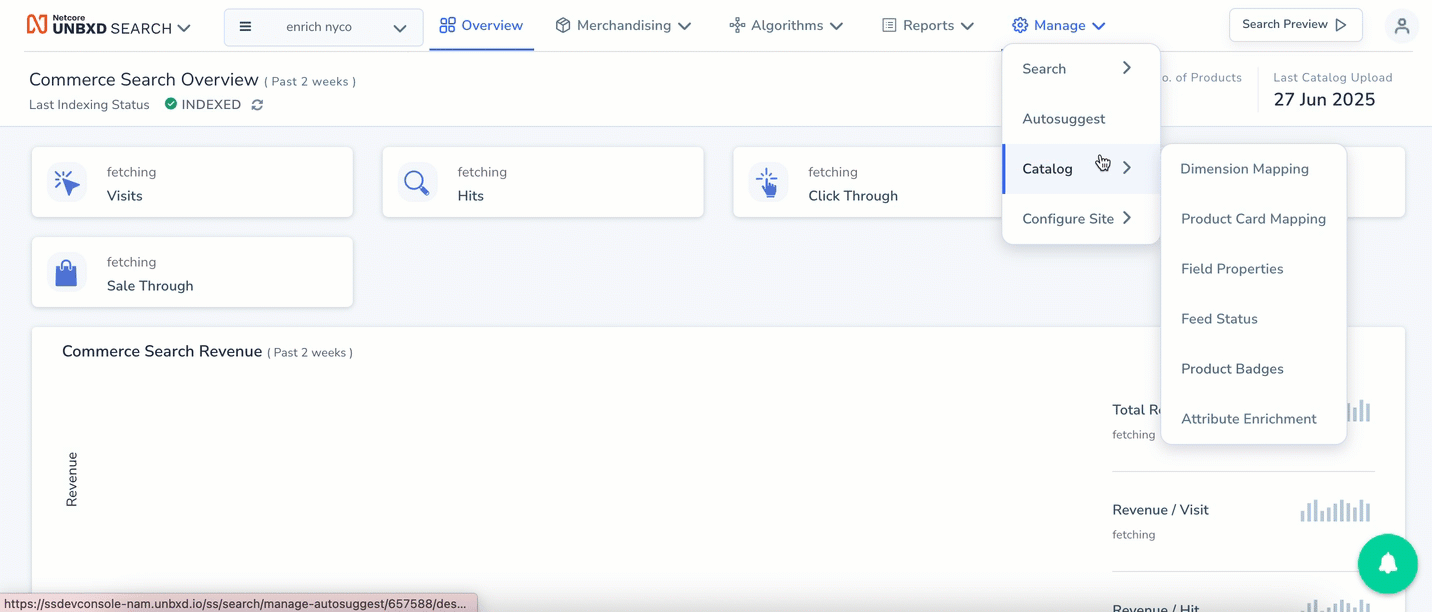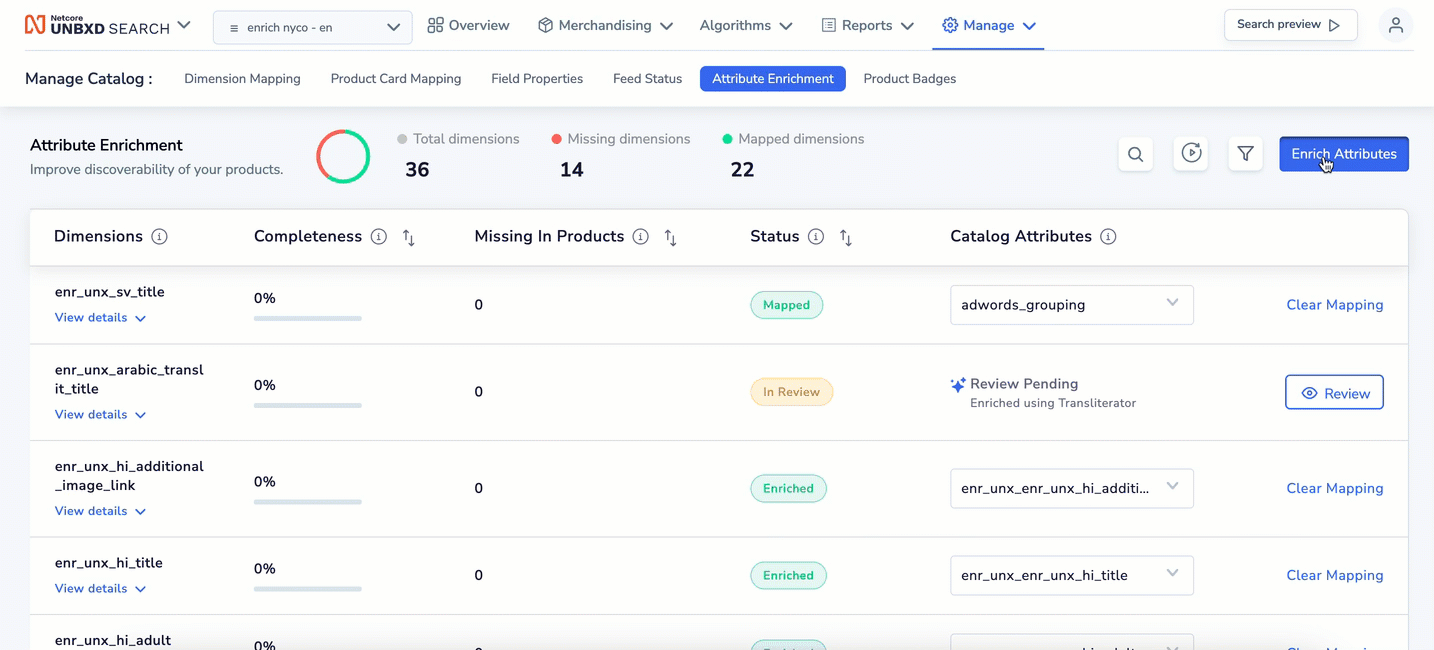Attribute Enrichment
Leverages AI to automatically fill in missing or incomplete product attributes, enhancing search visibility and improving product discoverability.
Overview
The Attribute Enrichment in the console aims to enhance catalog completeness for optimal search performance. This dashboard facilitates the identification of missing or incomplete attributes in product catalogs, providing detailed metrics and allowing merchandisers to prioritize enrichment efforts. It presents various attributes, their status, and their impact on search performance.
Why is this Useful?
Merchandisers often struggle with incomplete or inconsistent product data, such as missing attributes for key categories like material for a T-shirt or screen size for a Smartwatch. These gaps can lead to:
- Poor Search Relevance: Customers might not find products if key attributes are missing.
- Reduced Discoverability: Filters and facets relying on these attributes won't function effectively.
- Inconsistent Product Information: Leading to a fragmented customer experience.
AI Suggested Redirects leverages advanced strategies to intelligently suggest redirects based on past search patterns, filling in these gaps and improving product visibility. This ensures a smoother and more relevant shopping experience for your customers.
Product Enrichment Strategies
The Netcore Unbxd console offers four core enrichment strategies to help you optimize and enhance your product catalog.
- Large Language Models (LLMs)
This strategy harnesses the power of Large Language Models (LLMs) to intelligently generate new, missing product fields based on existing information in your catalog. It's ideal for creating descriptive content or structured data points that are not readily available.
For Example: For a "Smartwatch" missing the "battery life" attribute, the LLM analyzes the product description, such as "Up to 48 hours of usage on a single charge," and automatically adds the missing "battery life" data.
- Google Translator Enrichment
This strategy enables the translation of existing product fields from one language (typically English) into a specified target language. It helps expand your e-commerce presence into new markets and provides localized search experiences by generating multilingual product data.
For Example: Original Product Data:
{
"id": "PROD123",
"product_type": "Smartwatch"
}
{
"id": "PROD123",
"product_type": "Smartwatch",
"enr_unx_ar_translate_product_type": "ساعة ذكية"
} - Transliterate Enrichment
The Transliterate Enrichment strategy converts text from one script to another while preserving phonetic pronunciation. This is especially useful for search queries where users might type foreign words using English characters. It differs from translation by changing the script, not the meaning.
For Example : 1. English to Hindi Transliteration
{
"id": "GROCERY456",
"product_name": "Chawal"
} {
"id": "GROCERY456",
"product_name": "Chawal",
"enr_unx_hi_translit_product_name": "Rice"
} For Example: 2. Latin Script - Similar to Translation
{
"id": "PROD123",
"product_type": "Smartwatch"
} {
"id": "PROD123",
"product_type": "Smartwatch",
"enr_unx_es_translit_product_type": "Reloj inteligente"
}
``` |
This format simplifies the explanation and example for users, making it easy to understand the functionality of the **Transliterate Enrichment** strategy.- SEO Keyword Enrichment:
The SEO Keyword Enrichment strategy uses Large Language Models (LLM) to generate relevant SEO keywords for your products based on existing product data. These keywords help improve your product's visibility in organic search results, driving more traffic to your e-commerce site.
For Example: Configuration from fields: product_title, description, category
{
"id": "PROD789",
"product_title": "Organic Cotton Baby Bodysuit",
"description": "Soft and breathable 100% organic cotton bodysuit for infants aged 0-6 months. Features snap closures for easy diaper changes and a cute animal print. Perfect for sensitive skin.",
"category": "Baby Clothing"
} {
"id": "PROD789",
"product_title": "Organic Cotton Baby Bodysuit",
"description": "Soft and breathable 100% organic cotton bodysuit for infants aged 0-6 months. Features snap closures for easy diaper changes and a cute animal print. Perfect for sensitive skin.",
"category": "Baby Clothing",
"seo_keywords": [
"organic baby clothes",
"cotton bodysuit infant",
"newborn organic cotton",
"baby clothes 0-6 months",
"snap closure bodysuit",
"sensitive skin baby clothes",
"animal print baby outfit"
]
}
``` |
This format breaks down how the SEO Keyword Enrichment strategy works, providing a simple explanation and an example of how it generates SEO keywords from product data.
How to Get Started
Log in to Netcore Unbxd Dashboard and navigate to Manage > Catalog > Attribute Enrichment

Navigate to Attribute Enrichment
Dashboard Keywords and Their Functionality
Attribute Enrichment improves the discoverability of your products by ensuring that your product catalog has the necessary and complete attributes. There are three metrics of the Attribute Enrichment
| Metric | Description |
|---|---|
| Total Dimensions | The total number of attributes being tracked for enrichment in your product catalog. |
| Missing Dimensions | The number of attributes that are currently missing or incomplete in the catalog and need to be enriched. |
| Mapped Dimensions | The attributes that have been successfully mapped to the system, meaning they are linked and ready for enrichment. |
This below section on the dashboard, helps you monitor the overall progress of your attribute enrichment process and provides clarity on which attributes are ready, which ones are missing, and how many are already mapped for enrichment.
Section | Description | Use Case |
|---|---|---|
Search | Allows you to search for specific attributes or products in the catalog. It helps quickly locate dimensions or attributes that need enrichment. | |
Rerun | Triggers the enrichment process again for attributes. This button is useful for refreshing or recalculating attribute data when necessary. | |
Filter | Opens the Filter Options, where you can apply filters based on the below:
| |
Initiates the enrichment process for selected attributes. By clicking this, you can automatically enrich missing or incomplete attributes using AI-driven enhancements. | ||
Dimensions | It refer to standard attributes taken from Google taxonomy that should be present in your product catalog to enhance search performance. | For a motorsports merchandiser with a wide range of products like trousers, tires, helmets, and e-bikes, the attribute closureis only relevant for specific categories like trousers, not for others like tires or helmets. |
Completeness | Indicates the progress or percentage of completion for the enrichment process of the catalog. | For the same motorsports merchandiser, If only 60 out of 100 trousers have the closure attribute filled, then the completeness for that attribute is 60%. |
Missing In Products | This field indicates the number of products that are currently missing values for a particular attribute within the relevant categories. | If the closure attribute is missing for 40 out of 100 trouser products, the Missing in Products column will display 40, giving merchandisers a clear view of how many products need attribute enrichment. |
Status | The Status reflects the current stage of enrichment for an attribute. | Types of status on the dashboard:
|
Catalog Attributes | It refers to the catalog fields that have been mapped to other dimensions, such as Google attributes. This mapping shows the actual linkage between your product catalog and the Google taxonomy, ensuring that your product data is properly categorized and ready for search optimization. | if a customer uses prod_desc as their internal field name for product descriptions, this column will show prod_desc mapped to the Google standard Product Description, helping merchandisers clearly understand how their internal fields align with standardized attributes. |
Good to know:
- Google Taxonomy is a structured classification system used by Google to categorize products in various categories for search and shopping purposes. It is a standardized list of product categories that help organize products and ensure they appear in relevant search results across Google services, such as Google Search, Google Shopping, and Google Ads.
- Metrics such as Dimensions, Completeness, and Missing Attributes, are calculated only for products in relevant categories.
Add New Enrichment

Add New Enrichment
- On the Attribute Enrichment Dashboard, scroll on the Attribute listing page to click on Enrich Attributes.
- Select the Strategies that suit your requirement and click on Next.
- Configure your enrichment strategy and click Preview. Once Preview is generated, click on Run on entire catalog to proceed.
- Review generated attribute values in a sample set. You can download the enriched data file, make changes and re-upload it. Click on Publish to apply enriched data to the entire catalog.
Leverage Attribute Enrichment to boost your e-commerce platform’s search experience and overall conversion metrics.
Updated about 8 hours ago
